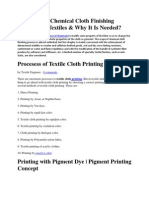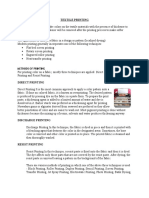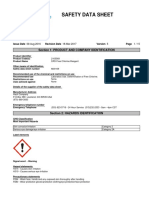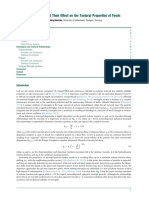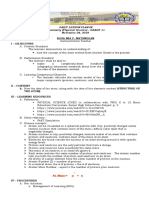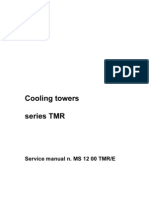0 ratings0% found this document useful (0 votes)
48 viewsStyles of Printing
Styles of Printing
Uploaded by
loki bThere are three main styles of printing fabrics: direct, discharge, and resist. Direct style involves applying dye directly to the fabric in paste form, allowing any pattern. Discharge style prints on dyed fabric, using a discharging agent to bleach the dye from printed areas. Resist style first applies a substance like wax to the fabric to resist dye, then dyes the rest of the fabric, leaving the resisted areas the original color.
Copyright:
© All Rights Reserved
Available Formats
Download as PDF, TXT or read online from Scribd
Styles of Printing
Styles of Printing
Uploaded by
loki b0 ratings0% found this document useful (0 votes)
48 views2 pagesThere are three main styles of printing fabrics: direct, discharge, and resist. Direct style involves applying dye directly to the fabric in paste form, allowing any pattern. Discharge style prints on dyed fabric, using a discharging agent to bleach the dye from printed areas. Resist style first applies a substance like wax to the fabric to resist dye, then dyes the rest of the fabric, leaving the resisted areas the original color.
Original Title
Styles of printing
Copyright
© © All Rights Reserved
Available Formats
PDF, TXT or read online from Scribd
Share this document
Did you find this document useful?
Is this content inappropriate?
There are three main styles of printing fabrics: direct, discharge, and resist. Direct style involves applying dye directly to the fabric in paste form, allowing any pattern. Discharge style prints on dyed fabric, using a discharging agent to bleach the dye from printed areas. Resist style first applies a substance like wax to the fabric to resist dye, then dyes the rest of the fabric, leaving the resisted areas the original color.
Copyright:
© All Rights Reserved
Available Formats
Download as PDF, TXT or read online from Scribd
Download as pdf or txt
0 ratings0% found this document useful (0 votes)
48 views2 pagesStyles of Printing
Styles of Printing
Uploaded by
loki bThere are three main styles of printing fabrics: direct, discharge, and resist. Direct style involves applying dye directly to the fabric in paste form, allowing any pattern. Discharge style prints on dyed fabric, using a discharging agent to bleach the dye from printed areas. Resist style first applies a substance like wax to the fabric to resist dye, then dyes the rest of the fabric, leaving the resisted areas the original color.
Copyright:
© All Rights Reserved
Available Formats
Download as PDF, TXT or read online from Scribd
Download as pdf or txt
You are on page 1of 2
Styles of Printing
Fabrics can be printed in three different styles namely direct, discharge and resist styles.
Styles Of Printing
Fabrics can be printed in three different styles namely direct, discharge and resist
styles.
1. Direct Style of Printing
The most common style of printing textile fabric is direct printing. In this method
the dye is directly applied onto the fabric. Dyes are used in paste form. It is the
simplest and oldest style of printing. It can be done on a white fabric or coloured
fabric. The dye is imprinted on the fabric in paste form and any desired pattern
may be produced. Dark colour prints in lighter background is the characteristic
feature of direct style printing. In this style of printing, the printing paste is
transferred to the selected areas of the fabric and the pigments adhere to the fabric
surface. Direct style of printing is used in block printing, screen printing or roller
printing methods.
easiest style of printing
economical
This style is easy, economical and suitable for printing both simple and
complicated designs.
2. Discharge Style of Printing
In this method, the fabric is printed on a dyed fabric. The printing paste used in
this method contains a discharging agent, which will bleach or destroy the colour
from the dyed fabric in the printed areas. The resulting white area is brighten the
overall design. Sometimes the base colour is removed and another colour is
printed in its place. The discharging agent is an oxidizing or reducing agent
capable of discharging colours by oxidation and reduction. Potassium chlorate or
sodium chlorate (oxidizing agents) and stannous chloride (reducing agent) are
commonly used discharging agents. The effects produced are very striking as the
white area obtained brightens the overall design. This style of printing enabled
intricate and fine designs to be printed on the fabric. If the fabric is not thoroughly
washed after printing, the strength of the fabric may be affected due to the use of
discharging agents. The advantages of discharge style of printing produces light,
bright colour on a dark background, printing is sharp and fine and easier to work.
However the major disadvantages of this method is the cost involved.
3. The Resist Style
In this method, the bleached fabric is first printed with a substance like wax, rice
paste, china clay or chemicals such as acids, alkalis and salts that resist dye
penetration and fixation. The printed fabric is then dipped in cold dye bath, so
that the resisting agent remains unaffected and only the areas free of the resist
agent are coloured. After dyeing process, the resist paste is removed, leaving
white or light coloured patterns on a dark background. Batik, tie and dye are
examples of resist printing. The durability of the fabric is not affected by the resist
method.
You might also like
- p4 Sa1 Science NotesDocument6 pagesp4 Sa1 Science NotesJane Wong67% (3)
- Textile PrintingDocument32 pagesTextile PrintingParthasarathi Jena100% (5)
- A–Z of Thread Painting: The Ultimate Resource for Beginners and Experienced NeedleworkersFrom EverandA–Z of Thread Painting: The Ultimate Resource for Beginners and Experienced NeedleworkersRating: 5 out of 5 stars5/5 (4)
- Technical Specification For TankDocument19 pagesTechnical Specification For Tankhelard68100% (1)
- Paul Stamets - How Mushrooms Can Help Save The WorldDocument5 pagesPaul Stamets - How Mushrooms Can Help Save The WorldRadu IliescuNo ratings yet
- Discharge PrintingDocument16 pagesDischarge Printingsakshi_mehra123No ratings yet
- WRL0005Document3 pagesWRL0005Fathima FarahNo ratings yet
- PrintingDocument7 pagesPrintingSajib Mahmud ShahriarNo ratings yet
- PrintingDocument61 pagesPrintingDeepthi channaNo ratings yet
- Printing & StylesDocument17 pagesPrinting & Stylesjoyshree ayekpamNo ratings yet
- Discharge PrintingDocument11 pagesDischarge PrintingRICHA VERMANo ratings yet
- Printing and Its TypesDocument6 pagesPrinting and Its TypesIftakharul IslamNo ratings yet
- Discharge Printing and Resist Style PrintingDocument15 pagesDischarge Printing and Resist Style PrintingRadhika AnandkumarNo ratings yet
- Printing TechnologyDocument18 pagesPrinting TechnologykazibweNo ratings yet
- Chapter 5. Styles of PrintingDocument52 pagesChapter 5. Styles of PrintingRitesh Reddy SeriNo ratings yet
- (Assignment) : Textile Chemical ProcessingDocument7 pages(Assignment) : Textile Chemical ProcessingAnshikaNo ratings yet
- The World of PrintingDocument54 pagesThe World of PrintingnadiaNo ratings yet
- Textile PrintingDocument6 pagesTextile PrintingAbdul Mujeeb100% (1)
- PrintingDocument90 pagesPrintingnadim69No ratings yet
- Textile Printing For FDTDocument36 pagesTextile Printing For FDTanowartexNo ratings yet
- Home ScienceDocument37 pagesHome ScienceMaria MärìàNo ratings yet
- Final Textile PrintingDocument26 pagesFinal Textile PrintingRamsha Mubeen100% (1)
- Hand Block Printing (Vakya)Document17 pagesHand Block Printing (Vakya)chikoti vakyapriyaNo ratings yet
- Akmal Finall Till NowDocument8 pagesAkmal Finall Till NowNabeel AhmedNo ratings yet
- Chapter 5. Styles of PrintingDocument32 pagesChapter 5. Styles of PrintingRitesh Reddy SeriNo ratings yet
- Wpe 2Document91 pagesWpe 2sahidhasan0152No ratings yet
- Textile Printing: Sri Lanka Institute of Texte & ApparelDocument40 pagesTextile Printing: Sri Lanka Institute of Texte & ApparelAjith SatyapalaNo ratings yet
- Color Properties of Printed FabricDocument58 pagesColor Properties of Printed FabricShashi KantNo ratings yet
- Pre Treatment For Fabrics Before DyeingDocument16 pagesPre Treatment For Fabrics Before DyeingNayomi Rathnaweera0% (1)
- PrintingDocument44 pagesPrintingHasibur RahmanNo ratings yet
- Printing Techniques and Printing Defects11Document15 pagesPrinting Techniques and Printing Defects11Supriya Bagh100% (1)
- Textile Printing (STYLE AND METHODS)Document40 pagesTextile Printing (STYLE AND METHODS)ARYAN RATHORE75% (4)
- Styles of Printing.docxDocument4 pagesStyles of Printing.docxfoysalmehadi131No ratings yet
- Dyeing, Printing 2Document15 pagesDyeing, Printing 2Sahadat Hossen100% (1)
- Direct Method of PrintingDocument18 pagesDirect Method of Printingitz4mine100% (1)
- Topics: Introduction of Printing: Tariqul Islam Wet Processing-II (WPE-343) Lecturer (TECN)Document3 pagesTopics: Introduction of Printing: Tariqul Islam Wet Processing-II (WPE-343) Lecturer (TECN)ইমরানুল শহীদ আলভীNo ratings yet
- Color Chemistry 1Document12 pagesColor Chemistry 1MD TausifNo ratings yet
- Textile Printing ClariantDocument9 pagesTextile Printing ClariantAkmal Javed0% (1)
- Southeast University: Department of Textile EngineeringDocument21 pagesSoutheast University: Department of Textile Engineeringjack omeNo ratings yet
- List of Ingredients and Their Functions Used in Printing PasteDocument4 pagesList of Ingredients and Their Functions Used in Printing Pastemahzabin MariaNo ratings yet
- Chapter 1. Introduction To Textile PrintingDocument18 pagesChapter 1. Introduction To Textile PrintingRitesh Reddy SeriNo ratings yet
- A Typical Printing Process Printing Paste PreparationDocument15 pagesA Typical Printing Process Printing Paste PreparationFathi MustafaNo ratings yet
- Fabric Dyeing, Printing, and Finishes: Apparel and Textile Production IiDocument33 pagesFabric Dyeing, Printing, and Finishes: Apparel and Textile Production IiSachin RoyNo ratings yet
- Printing Styles and MethodsDocument27 pagesPrinting Styles and MethodsRoja JayaramNo ratings yet
- c 20 -Printing (1)Document16 pagesc 20 -Printing (1)foysalmehadi131No ratings yet
- Typical Printing Process - Printing Dyes, Auxiliaries & TechnologyDocument48 pagesTypical Printing Process - Printing Dyes, Auxiliaries & TechnologyRikta IslamNo ratings yet
- Printing On TextilesDocument23 pagesPrinting On TextilesMukul Kishore PandeNo ratings yet
- Resist Styles of Printing EditedDocument15 pagesResist Styles of Printing Editednandiniaggarwal9317No ratings yet
- Textile Dyeing and Printing: Presented by SHEHLA QayyumDocument20 pagesTextile Dyeing and Printing: Presented by SHEHLA QayyumAmna liaquatNo ratings yet
- Discharge Style of PrintingDischarge Style of PrintingDocument8 pagesDischarge Style of PrintingDischarge Style of PrintingAman DeepNo ratings yet
- PrintingDocument2 pagesPrintingZlimsmartNo ratings yet
- Hamza Flexible PrintingDocument26 pagesHamza Flexible PrintingarslanNo ratings yet
- Fusing MachineDocument23 pagesFusing MachineAneesha PandaNo ratings yet
- Textile Dying and PrintingDocument11 pagesTextile Dying and PrintingAvantika VermaNo ratings yet
- Different Types of Printing Techniques On FabricDocument51 pagesDifferent Types of Printing Techniques On FabricRikta IslamNo ratings yet
- Printing ProcessesDocument8 pagesPrinting ProcessesPriyanka ChaudharyNo ratings yet
- Sublimation Print For Textile MaterialDocument8 pagesSublimation Print For Textile MaterialVasant KothariNo ratings yet
- Printing TextileDocument23 pagesPrinting TextileShresha DasNo ratings yet
- Printing Images Textiles Paper: Woodblock Printing Is A Technique ForDocument18 pagesPrinting Images Textiles Paper: Woodblock Printing Is A Technique ForKhushboo Rajpal0% (1)
- 2019-20 - B40EA Distillation AssignmentDocument3 pages2019-20 - B40EA Distillation Assignmentojasmainkar123No ratings yet
- Safety Data Sheet: Section 1: Product and Company IdentificationDocument15 pagesSafety Data Sheet: Section 1: Product and Company IdentificationrbozaNo ratings yet
- Transvac TransPACDocument12 pagesTransvac TransPACDmitrii ChernushkinNo ratings yet
- Microgel Particles and Their Effect On The Textural Properties of FoodsDocument9 pagesMicrogel Particles and Their Effect On The Textural Properties of Foodsmsa_imegNo ratings yet
- Types of Chemical ReactionsDocument7 pagesTypes of Chemical ReactionsNabil AbdullahNo ratings yet
- Shell Tellus S2 MX 46: Performance, Features & BenefitsDocument3 pagesShell Tellus S2 MX 46: Performance, Features & Benefitsphucdc095041No ratings yet
- Test Method: Renault Automobiles Standardisation DQSC - S / Department 00621 Section Normes Et Cahiers Des ChargesDocument9 pagesTest Method: Renault Automobiles Standardisation DQSC - S / Department 00621 Section Normes Et Cahiers Des Chargesclaudio5475No ratings yet
- Fabric Softener: 14% Concentration (Cold Process)Document2 pagesFabric Softener: 14% Concentration (Cold Process)Chemist Technologist100% (1)
- 16MnCr5 1.7131 16MnCrS5 1.7139 RM16 ENGDocument2 pages16MnCr5 1.7131 16MnCrS5 1.7139 RM16 ENGJerzy RistujczinNo ratings yet
- Panchvidh Kashay KalpanaDocument53 pagesPanchvidh Kashay KalpanashreerangayurvedNo ratings yet
- Organic and Inorganic Zinc Rich CoatingsDocument3 pagesOrganic and Inorganic Zinc Rich CoatingsEddy Norman Benites Delgado100% (6)
- BASF xl-80Document6 pagesBASF xl-80saifNo ratings yet
- Eppendorf 5804R Centrifuge ManualDocument42 pagesEppendorf 5804R Centrifuge ManualUma Mahesh100% (1)
- Sparkler CompositionsDocument3 pagesSparkler CompositionsMuthu KumarNo ratings yet
- Class-X FSTDocument2 pagesClass-X FSTRusheek DhawanNo ratings yet
- Prima CoalDocument8 pagesPrima CoalMarvin E. VillanuevaNo ratings yet
- Kirgen Cat 2012 PDFDocument12 pagesKirgen Cat 2012 PDFCESPIPERUNo ratings yet
- Lec 1Document38 pagesLec 1Pavithra SivanathanNo ratings yet
- Omnian PANalytical Day 2009 FinalDocument32 pagesOmnian PANalytical Day 2009 FinalAdrian ZazzNo ratings yet
- Engineering Materials Geoffrey W Meetham M B E Prof DR Ir Marcel H Van de Voorde Auth Materials For High Temperature Engineering Applicati PDFDocument173 pagesEngineering Materials Geoffrey W Meetham M B E Prof DR Ir Marcel H Van de Voorde Auth Materials For High Temperature Engineering Applicati PDFIlham HakikiNo ratings yet
- X-Flow Aquaflex 40: Ultrafiltration MembraneDocument2 pagesX-Flow Aquaflex 40: Ultrafiltration MembraneChalut YvesNo ratings yet
- Chemistry-Nuclear Model of An AtomDocument10 pagesChemistry-Nuclear Model of An AtomRosa Mia Paglilingan100% (1)
- TMR Service ManualDocument35 pagesTMR Service Manualalzobir2003No ratings yet
- How To Make Fermented Fruit Juice or FFJDocument12 pagesHow To Make Fermented Fruit Juice or FFJPol Gas100% (5)
- RinciDocument6 pagesRinciSabaruddin HarahapNo ratings yet
- EOSProject WorksheetSY2023 - 2024Document4 pagesEOSProject WorksheetSY2023 - 2024Block 18 -RAMADILLANo ratings yet
- MX Multi Sensor Aspirating Smoke Detector AMX 4002 PDFDocument2 pagesMX Multi Sensor Aspirating Smoke Detector AMX 4002 PDFNarendra Reddy BhumaNo ratings yet




























